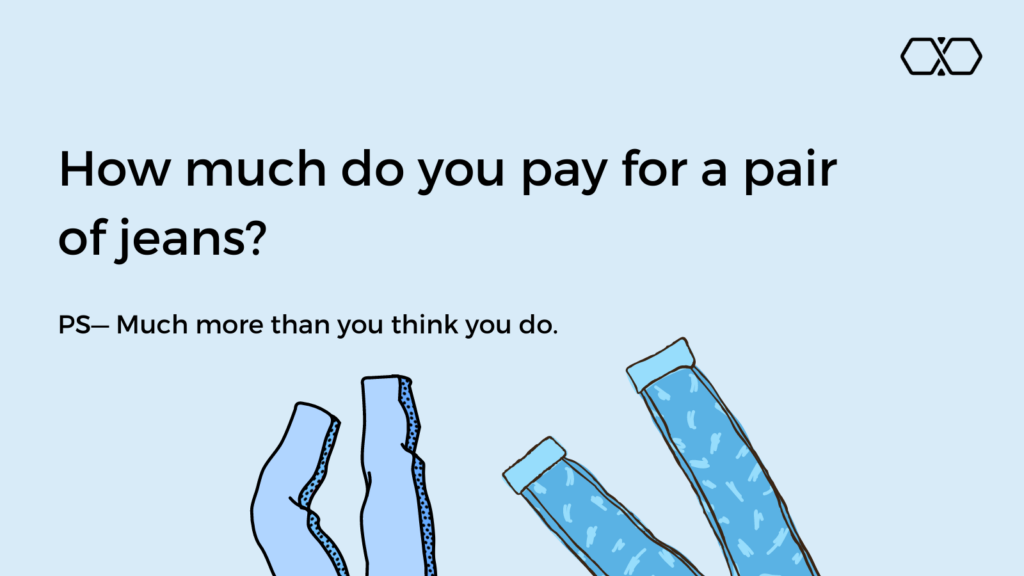Did we pay only what was mentioned on the bill while buying that new dress or a pair of jeans? Well, No! Not only did we pay much more but we also paid in form of extremely precious things. It is like giving away grains over coins when faced with a food shortage. How can we protect ourselves from making such a mistake?

What do you pay?
Let us first understand, if not in cash, what exactly do we pay. If you bought a dress made of viscose, you must have paid by giving away trees from the forest and thus in the currency called clean air and biodiversity; If you bought cotton denim, you must have paid in the currency of water, that too in the amounts that you could have survived on for around a decade; If you bought a polyester top, you must have signed up for letting microplastics destroy that poor fish and your health. This is where we need to know that fashion isn’t ever really cheap – instead of dollars, you barter your natural luxuries. To know how you can minimize this barter, Let’s start by breaking up your bill.
How much do you pay?
Here’s what you might be paying for one pair of jeans:
- The amount of carbon emitted during the entire lifecycle of a pair of Levis 501 jeans is approximately 33.4 kg CO2-e, which is roughly 111 Kms driven by a car or a watching TV for 264 hours on a big plasma screen TV.
- The water consumed is 3718 Liters which can easily provide the total need for a US household for 3 days.
- The amount of phosphorus leeched causing eutrophication is 48.9 g PO4 -e which is equivalent to the phosphorus found in 1000 tomatoes.
And much more…
What causes this?
Levi Straus, a popular jeans manufacturer, has provided an estimate of the breakdown of the overall emissions for their popular 501 jeans after conducting its Life Cycle Assessment (LCA). While 33% of emissions come from fabric production, the cutting, sewing, and finishing of the product take 8%, packaging, transport, and retail is 16% and the rest, which accounts for close to 40% is from customer use.
While there is a lot of science that needs to be studied, one of the most impactful things is – Fibers and materials. Not only do they have their footprints but they also affect the usage footprint and end of life of the final product. Thus, we rely on extensive science and agile execution to pull sustainability, inclusivity, and performance in every inch of the materials that we make by putting to use agriculture waste. Stay tuned with us to decode these different materials in upcoming blogs.
What can you do?
Here are our top three recommendations to keep your real bills down and shop smart:
- Be wise with what you buy!
Fashion is an immediate language – it is the way you express yourself and thus it is more of a reason why you should pick wisely. Check labels and pick what is made with more sustainable materials and sustainable processes, preferably biodegradable as the world currently lacks a supply chain and infrastructure to collect back things for worthy recycling. Do not shy away from paying an extra buck in cash than paying in currencies of clean air, water, health, etc.
- Usability is definitely all in your hands!
It is not ideal to wash all the clothes after each wear. Depending upon in what conditions you wore it, one can often wear things like denim, jackets for more than once or twice. Have a capsule wardrobe so that you can pair up things differently and increase your number of uses without losing on your style game. Style isn’t only about wearing new clothes, but also about knowing how to pair things differently and maximizing their usage, etc.
- Is the end really the end?
Sometimes all it takes is to repair your clothes, other times depending on the condition you can sell it on a second-hand clothing store, or give it to a thrift store, or donate it. If they are not in shape, you can downcycle them to make them a cleaning cloth as people do in South Asian cultures. If they are compostable, you can use your compost. If it is biodegradable try that – and this is one of the key reasons why you should prefer bio-materials right from the start. See if you can help to put this t-shirt back in the recycling supply chain.
Would you be wise to harness not only the power of money but also the currencies of water, air, climate, health, biodiversity while choosing your clothes?